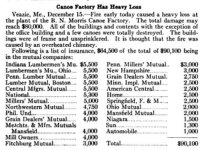Here’s a post on the WCHA.org website I found in response to a member asking if he should use Dacron on his older wood canvas canoe. At the time, I was considering Dacron but I choose to stick with canvas for a few reasons, one was my skill level, but I was mostly suspect of the durability of Dacron in the end. I’m still not convinced it’s as durable as canvas or is suitable for a tripping canoe as a stand alone canoe covering.
Todd Bradshaw said,
“Whether working inspecting and repairing hot air balloons or making sails, I've probably used more Dacron (polyester) over the years than just about anybody here. Though there are certainly differences in the types and to some extent the properties of various Dacron fabrics, there are also some aspects that fairly similar versions all share. Despite what you seem to have heard, Dacron is not a super tough, super high tensile strength fabric, and very often has really poor resistance to tearing.
Much of this is due to the limited amount of stretch that the fiber has (compared to most other synthetics, like nylon). This is good for canoes and fixed wing aircraft, as it resists "bagging out" with age pretty well, but bad as it isn't really thick enough to resist abrasion very well and those styles of Dacron tend to be subject to what is called "explosive tearing". This is when a small cut or defect suddenly and quickly expands big time. On a Dacron balloon envelope or a sail, this can mean that within a few seconds, a small tear can expand from 2" long to seventy feet long if there isn't some reinforcement to stop it.
The key issue, nutshell version, is that the stretch-resistant yarns of the Dacron fabric don't help each other out very much. The first yarn tries to take all the strain and then breaks, then the second yarn tries the same thing with the same result, followed by the next, and next, and next. Fibers with more give (like nylon) stretch when strained and the stress is spread over many at once, giving the finished cloth better tear resistance. Nylon has some drawbacks of its own, so there is no way I'd personally put either one on a canoe. They also really do show every tiny irregularity in the planking, which often looks awful on old canoes which aren't quite as smooth as they once may have been. In general, for good looks and actual, real-life durability, I think you'll find canvas very hard to beat.”














